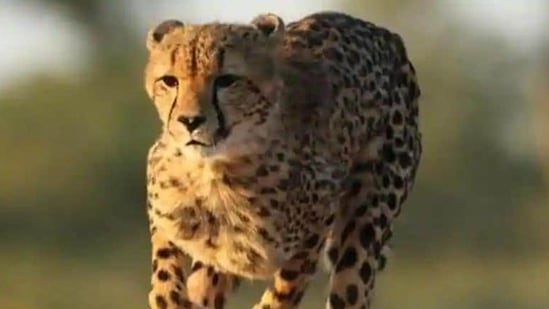Namibia wants ivory trade clause in deal for sending cheetahs to India
However, according to officials from both sides, New Delhi is unlikely to be able or want to meet the condition.
Bhopal: Namibia wants India’s support for lifting a United Nations ban on commercial trade of wildlife products, including ivory, for translocation of cheetahs to Kuno Palpur Wildlife Sanctuary in Madhya Pradesh, a condition New Delhi is unlikely to be able or want to meet, Indian and Namibian officials familiar with the matter said on Thursday.

Also Read | India delegation heads to Namibia to discuss cheetah translocation
Trade of wildlife body parts is banned under the United Nations Convention on International Trade in Endangered Species of Wild Fauna and Flora (CITES), a body that regulates trade of wildlife products across the globe. Namibia and a few other countries want CITES to lift the ban on certain wildlife products so that they can sell stockpiles of ivory and other wildlife parts internationally. The issue is on the agenda of the CITES meeting to be held in Lyon, France, next month. Namibia wants the support of India, a signatory to CITES, in this regard.
According to Indian government officials, the condition to support Namibia for “sustainable utilisation of wildlife” is part of the draft memorandum of understanding Namibian officials have shared with a five-member delegation from India that visited the African country from November 18 to 22. The Indian delegation included officials and experts from the Ministry of Environment, Forest & Climate Change, Madhya Pradesh government and Wildlife Institute of India (WII).
The project to translocate cheetahs from Africa to India is a long-term one being implemented by the environment ministry with the help of the Wildlife Institute of India. The Supreme Court appointed an expert panel, which approved Kuno Palpur as the possible location for cheetah relocation.
In the past six months, the Madhya Pradesh forest department has relocated villagers from Kuno and has prepared an enclosure with round-the-clock surveillance for reintroduction of cheetahs. Initially, the department estimated that it would get cheetahs from Namibia by February but now the officials say they expect the fastest animal on land to reach Kuno by May.
However, the condition raised by the Namibian government could be an impediment for the first-of-its-kind project to take off. Officials said agreeing to such a condition will not be possible as India’s domestic laws prohibit any trade of wildlife body parts.
Madhya Pradesh principal secretary (forest), Ashok Barnwal, who was part of the delegation, said, “India can’t support Namibia on utilisation of wildlife and trade. India always works for conservation (of wildlife), not on utilisation. It is impossible to agree on this. India’s ministry of environment is amending the MoU (memorandum of understanding), especially this point. Let’s see how the Namibian government responds to it.”
An environment ministry official familiar with the development said the negotiation on the MoU with Namibia is still underway and expressed hope that the issue will be resolved.
Confirming that the MoU has been shared with India, Namibia’s ministry of environment, forestry and tourism, chief public relations officer Romeo Muyunda said talks are on with the Indian government.
“The (Namibian) ministry has suggested in the draft MoU for the two governments to support each other in sustainable utilisation of wildlife in general, not necessarily in the trade of ivory and export of live specimens of African elephants. The Indian government is considering the terms of the MoU,” Muyunda said
Muyunda said he could not give the exact number of cheetahs to be relocated as the Indian government was sourcing them from a non-government organisation, Cheetah Conservation Foundation.
The Indian delegation has met Namibian deputy prime minister Nerumbo Nandi-Ndaitwah, and senior officials from the ministry of environment, forestry and tourism and the Cheetah Conservation Fund. “There was a lot of discussion on the scientific aspects of such a big translocation,” an Indian government official said, adding that the CCF would give three to five cheetahs in the first go.
According to wildlife experts, Namibia wants India’s help as several international NGOs are campaigning against the proposal to allow limited commercial trade of seized wildlife body parts.
An expert, familiar with the matter but not willing to be named, said four southern African countries, including Namibia, are trying hard for the lifting of the ban on ivory trade.
“Last year, they were also planning to break away from CITES. Similarly, in December 2020, Namibia announced it would auction 170 African elephants. In February this year, the ministry of environment, forestry and tourism released a statement that it is in the process of capturing 57 elephants and 42 will be exported.”
South African wildlife expert Andrew Ranching said sustainable use of wildlife resources is utilising them in a way that does not lead to degradation of the environment.
“If international trade in ivory was legal, then it might be possible to have sustainable trade in ivory. That would require selling ivory from stockpiles and harvesting ivory from animals that die naturally. I think the parties to CITES should base their trade decisions on scientific evidence,” he added.
Indian government officials admitted that New Delhi will have to depend on Namibia for getting cheetahs as South Africa has not shown any interest, so far, in sending the cats to India. “There has been no response from the South African government,” the official said. India was expecting to get 30 to 40 cheetahs from South Africa, officials said.
Get Current Updates on India News, Lok Sabha election 2024 live, Election 2024 along with Latest News and Top Headlines from India and around the world.




